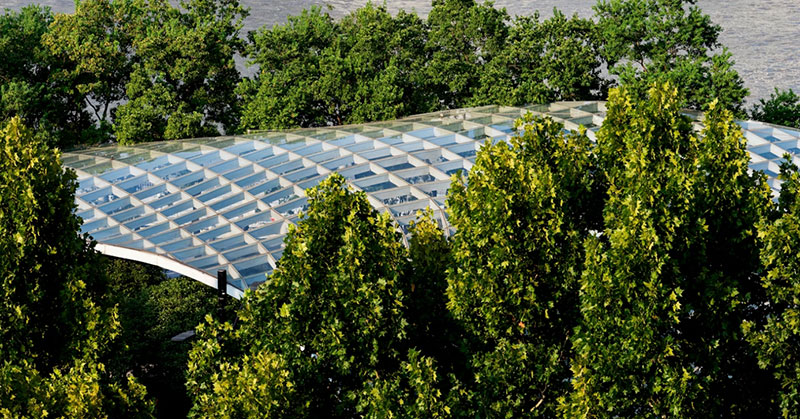
Companies now realize that sustainable construction isn't just about being environmentally responsible; it also makes financial sense. Energy-efficient factories cost less to run, last longer, and often attract positive public perception.
In this article, we'll explore the key elements that define sustainable factory construction and how to apply them to new or existing industrial projects.
Strategic Site Planning and Development
The
factory construction process for sustainability starts with site selection. Careful consideration in choosing the location can significantly reduce the environmental footprint. Instead of building on greenfield sites, some developers now turn to brownfield redevelopment—reusing former industrial land rather than encroaching on natural reserves.
Site selection tips:
- Use sites near existing facilities to reduce transport emissions.
- Analyze sunlight exposure and wind direction to facilitate the efficient use of renewable resources.
- Conserve local flora wherever possible to preserve biodiversity.
Making these decisions early in the design phase not only benefits the environment but also contributes to lower operational costs and improved long-term efficiency.
Energy-Efficient Factory Design
Improving energy efficiency is a key pillar of sustainable factory construction. Factories require vast amounts of energy to power lighting, equipment, heating, and cooling systems. By focusing on smart, energy-conscious design, companies can dramatically reduce energy costs and minimize environmental impact.
Energy-Saving Design Features:
Natural Lighting
Maximizing natural lighting is a practical and sustainable way to reduce energy consumption in factory buildings. By installing skylights, clerestory windows, and large glazed openings, facilities can minimize dependence on artificial lighting throughout the day. Not only does this lower electricity costs, but it also improves employee wellbeing by creating a brighter, more comfortable working environment. The strategic placement of windows also enhances passive solar gain, which can contribute to heating in colder seasons.
Thermal Insulation
Effective thermal insulation is essential for maintaining indoor temperature stability and reducing the need for excessive heating or cooling. Using insulated panel walls and roofing systems helps prevent unwanted heat exchange between the inside and outside of the building. This results in a more consistent indoor climate and significantly lowers HVAC energy demand. Additionally, advanced insulation materials, such as insulated metal panels with foam cores or recycled content, further contribute to the building’s overall sustainability and energy efficiency.
Smart HVAC Systems
Smart HVAC systems are equipped with sensors and automated controls that adjust airflow, temperature, and humidity based on real-time occupancy and ambient conditions. These systems not only improve indoor air quality but also prevent unnecessary energy use when certain areas are unoccupied.
Implementation of Steel structure Building Information Modeling (BIM) software during the design optimizes all elements of the building's performance. Learn how BIM makes buildings more sustainable at Autodesk.

Use of Sustainable and Recycled Materials
Material selection plays a critical role in reducing a building's environmental footprint. Using recycled or responsibly sourced materials ensures that the impact on natural resources is minimized while still meeting structural requirements.
Common Sustainable Materials:
- Recycled Steel: Strong, durable, and fully recyclable.
- Fly Ash Concrete: Reduces the use of Portland cement, which is highly carbon-intensive.
- Bamboo and FSC-Certified Wood: Fast-growing, renewable materials.
Using local suppliers also decreases transport emissions and boosts the local economy.
Water Conservation and Management Systems
Sustainability is not energy and materials-based—it's water-based as well. Water is often used for cooling, washing, and processing in manufacturing facilities. Effective use of water and management are required to prevent environmental stress.
Water-Saving Techniques:
- Rainwater Harvesting: Collect rainwater to use in bathrooms and gardens.
- Greywater Recycling: Reuse sink and equipment water for non-drinkable purposes.
- Low-Flow Fixtures: Use low-flow tap and toilet fixtures to reduce daily water usage.
Environmentally friendly factories use intelligent water meters and leak sensing to be cost-effective in the long term.
Integration of Renewable Energy
Modern factories are designed to either include or accommodate the future installation of renewable energy systems. Solar panels, wind turbines, and even geothermal solutions are increasingly being adopted to reduce reliance on fossil fuels and promote long-term sustainability.
Key Benefit:
- Cost Savings: Save long-term money on energy by generating your own.
- Reduction in Carbon Footprint: Help meet emissions goals and business regulations.
- Grid Independence: Local generation reduces exposure to energy price volatility.
- The Tesla Gigafactory is the best case in point, which will operate exclusively on renewable power.

Sustainable Construction Practices
Other than materials and design, even construction needs to adhere to sustainable practices. Traditional construction generates tons of waste and ecological damage. Factory building through sustainable construction has created procedures that reduce the on-site footprint.
Sustainable Practices:
- Prefabrication: Build components off-site to reduce construction time and waste.
- Modular Building: Use repeatable standard modules that are simple to transport and build.
- Just-in-Time Delivery: Reduce onsite clutter and waste of materials.
Smart Monitoring and Maintenance Systems
Regardless of the environment-friendliness of the building, it won't be successful if unmonitored. Electronic monitoring through energy and maintenance management tools ensures long-lasting performance after construction.
Long-Term Sustainability Tools:
- IoT Sensors: Track energy use, indoor air quality, and system performance in real-time.
- Predictive Maintenance: Use data to detect and repair issues before inefficiency.
- Energy Dashboards: Facilitate facility managers to visualize trends and make intelligent decisions.
These devices make certain that sustainable factory construction is not just a point-in-time success but a continuous process. Learn
how to encourage green construction all over the world.
Summary
Bringing sustainability to factory buildings is more than a trend—it's a new business model. With planning that protects the site, energy-conserving design, renewable energy, and clever construction methods, companies can insulate their operations and get in harmony with global sustainability goals.
Money is saved, employee health is improved, and brand value is added through sustainable factory construction development. You are planning to build a new facility or upgrade an existing one; now is the time to embrace sustainable design.
Uncover
XTD Steel Structure's vision of new Steel Factory Design that combines sustainability with structural performance.


